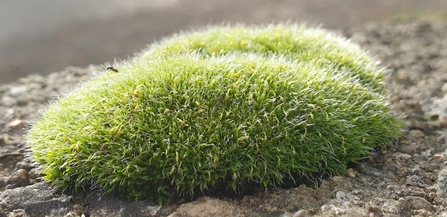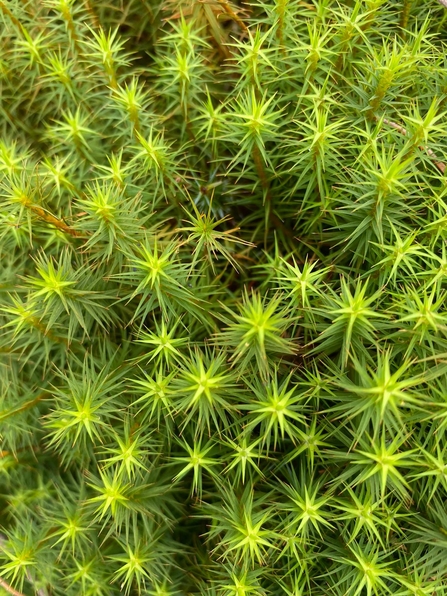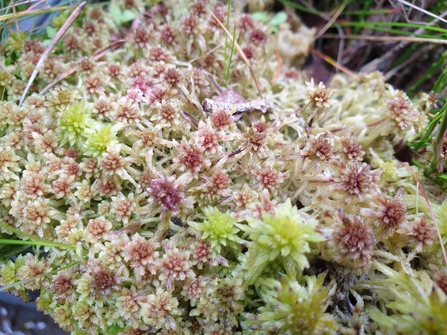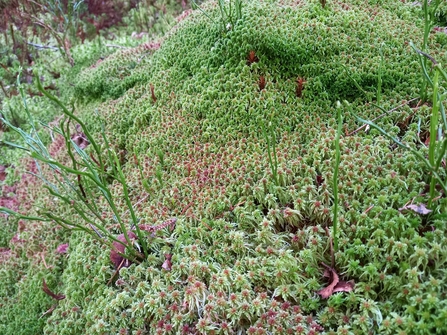Moss (Bryophyta) is perhaps the most unassuming of vegetative matter. The living ancestor of the plant kingdom, and the child of algae, it’s accepted by most botanists to be one of the first organisms to make the great transition from the sea to the land. And yet, at a distance, it’s probably often perceived as nothing more than a uniform patch of green amongst the grasses and the shrubs of our countryside. However, at any time whilst walking through a wood, should the sun break through and shine a light on it, an intricacy of colour and form, better representative of its true characteristics would be revealed – endless complexity masquerading as simplicity.

Grimmia pulvinata, also known as Grey-cushioned Grimmia, is common in temperate climates worldwide. Photo: © Tamasine Stretton
If I have seen further it is by standing on the shoulders of giants...
The well-worn and oft-referenced quote by Sir Isaac Newton is equally applicable to the relationship of all the land-based organisms of our modern world and the mosses. Without these humble rootless plants, there would be nothing.
Mosses arrived on the land in the Ordovician period, roughly 470 million years ago. Through their sequestering of carbon dioxide, these simple organisms gradually reduced global temperatures by eight degrees, massively changing their environment and, it’s thought, triggering the ice ages on this planet. I always feel that this is an incredible feat for such inconspicuous and innocuous little organisms.
Slowly but surely
Mosses grow very slowly, using chlorophyll A, B + C to adapt to the light resources available to them. Often this is only five percent of the ambient light. They are poikilohydric – their water content reflects that of their environment. These little plants are the kings of the boundary layer, growing only in this thin environment just above the ground’s surface where it is warmer, stiller, moister and higher in carbon dioxide, primarily to avoid the dehydrating effect of higher airflows above. In fact, the boundary layer in any given location can be measured by the height of the mosses there. Species of moss have a tremendous diversity of form, as different from each other as oaks from birch, and ash from pine. With roughly 12,000 moss species worldwide, they range in size from Ephemerum at 1mm, to Dawsonia at 30cm! They range in form too, from the hairy eyebrow Greater Fork-moss (Dicranum Majus) to the compact little lump that is Levier’s Beardless-moss (Weissia levieri).
Fruiting Dicranum majus moss. Photo: © Tamasine Stretton
Marvellous, magnificent and mesmerising
Since childhood, I’ve been drawn to these seemingly simplistic lifeforms: unchanging over millions of years, as their successors adapted new systems to thrive amidst challenging environmental changes. As a practising artist, I’ve been drawn to, inspired by and used moss in the creation of works. To me, it is the most humble yet dynamic of organisms. It manifests a calm and ancient stillness.
Mosses developed crucial survival techniques that would not only ensure their survival, but also the complex genetic and hormonal abilities that characterise the key functions of the plant world. Recent studies conducted at the University of Washington in St. Louis has been looking at the evolution of mosses – specifically Physcomitrella patens, or the Spreading Earth-moss – as they made the transition from sea to land and developed biological adaptions. Without their evolution of the plant hormone Abscisic acid (ABA) – which allows many mosses to survive desiccation, or extreme drying out – seeds wouldn’t be able to survive long periods of dormancy.
Moss is to be found on every continent on this planet, carried on and spread by the winds. Everywhere from the Arctic – where ancient mosses more than 50,000 years old, found buried under the glaciers of northern Canada, were ground up and cultivated, quickly regrowing – to the Antarctic, with the same amazing properties. In deserts across the world too, mosses cling to life, fed only by the moisture of the morning dew. Syntrichia caninervis is optimised to these intense environments. At first glance, these desiccated and blackened organisms seem dead. However, the blackness is caused by the moss laying down coats of sunscreen on the pigment layer to protect them from the withering and dehydrating effects of UV and wind. Only salty environments are unsuitable habitats for mosses.

Moss comes in all different shapes and sizes, but is almost always incredibly beautiful. Photo: © Ceri Jones
A multitude of uses
If that wasn’t enough to amaze and impress you, the use and properties of moss are so varied. Caribou, voles and lemmings all consume mosses to regulate digestion. Caribou, in particular, have been studied using it as an antifreeze for their blood on their winter migrations. Birds and small mammals use it for nesting material. Specifically, the songbirds use moss for its antimicrobial and antibacterial properties to protect their young, which defecate in the nest.
The list of benefactors are countless. Trees and plants benefit from the retention of water in the ground that moss provides, as well as reducing erosion during flooding. Moss can be thought of as the coral reef of the land. They act as perfect seed beds, aid fungi by maintaining a moist environment and provide habitat for thousands of organisms. Moss is so well-defended chemically – predominantly polyphenolic compounds and tannins – and so low in nutrients that few predate it. Some herbivores and larvae graze on the epiphytic algae growing on the moss and some birds are known to consume the sporophytes, but in a minimally impactful way on its survival.
Humans have also used mosses of many varieties for a multitude of purposes. Clubmosses were used for everything from incendiaries to suppositories. Sphagnum moss – of which there are over 380 types globally (34 in Britain) – has been used as wound dressing, insulation and babies’ nappies. During the First World War, as cotton bandages ran out, Sphagnum – and specifically S. papillosum and S. palustr – was found to be not only effective in disinfecting wounds, but also able to store 20 times more liquid than cotton. Ninety percent of the cells in moss are dead, but deliberately so, as the dead cells act as vessels to hold water. By the middle of the First World War, a million of such dressings – all cut from Sphagnum moss, from peat bogs – were being used per month, such was their effectiveness.
This Orthotrichum affine (Wood Bristle-moss) is growing on a tree branch. Photo: © Tamasine Stretton
Super Sphagnum
Sphagnum - and the peat bogs they form - are the primary store of sequestered carbon on this planet. It is estimated that carbon stored in the UK’s peat bogs alone represents 50-100 years of the country’s emissions from burning fossil fuels. These layers of peat are formed over hundreds of years and are up to 10 metres deep. The peat bogs themselves are made up of the dead Sphagnum and other plants, all preserved in the low oxygen and acidic environment.
In the mid-Wales area, the most common species are the Red Bog-moss (Sphagnum capillifolium), the Cow Horn Bog-moss (Sphagnum denticulatum) and Flat-topped Bog-moss (Sphagnum fallax). As well as acting as vital carbon sinks (or stores), these mosses also provide unique habitat to a myriad of species such as spiders, snails, nematodes and tardigrades.

A red-coloured Sphagnum moss. Photo: © Daniel Hodgkiss
Unsung climate change hero
As the human race strives to reduce atmospheric carbon and methane to mitigate the impacts of climate change, conservation of peat bogs is now recognised by many as essential – something Montgomeryshire Wildlife Trust are doing on their Cors Dyfi Nature Reserve with the help of a family of three Beavers, whose natural behaviours protect and encourage the peat bog in a low-impact and mutually beneficial way.
The planet’s moss sequesters more carbon than all the combined efforts of the trees, which in the dramatically changing times we live in makes it an unsung hero of the climate change movement. So, it may seem simple, it may be old, but please look closer when you get the opportunity. Mosses are a world unto themselves: a microcosm of form and life and light.

Sphagnum moss with a few cheeky tufts of polytrichum moss. Photo: © Clive Faulkner

